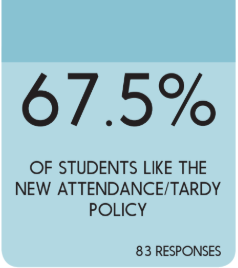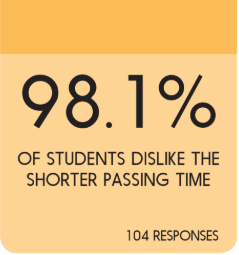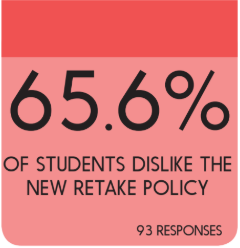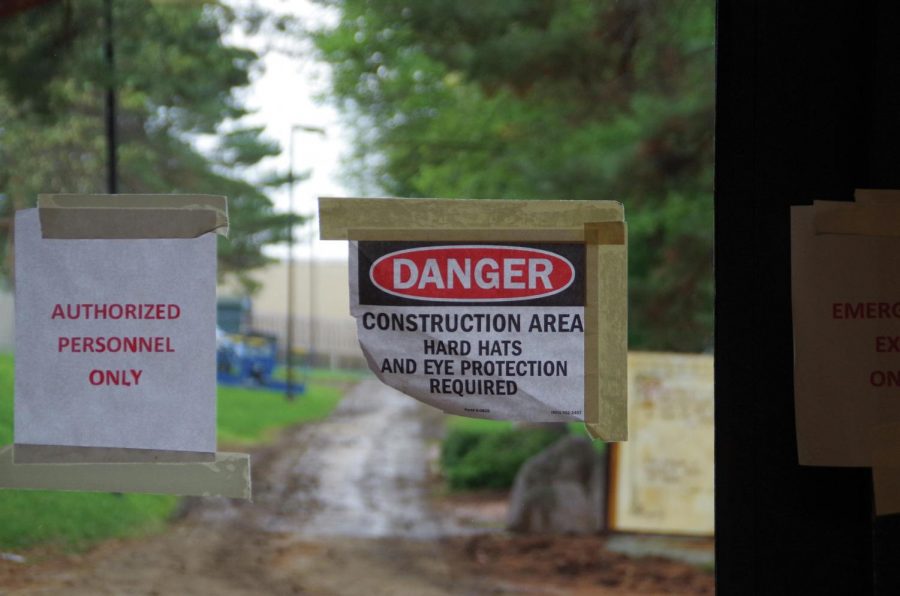Upside down and backwards
From new attendance policies to construction, West High is in the midst of getting a makeover of its own.
Signs warning students not to enter the courtyard because of construction (and rain).
As students returned from summer break, they were herded into Arganbright Auditorium for a first day school assembly. The attitude was the same as past assemblies: bored, discontented students in every direction. That was until Principal Gregg Shoultz opened his presentation, “7 Memes to Start the School Year” and brought everyone’s attention to a few important developments. A few of those developments, conveyed through references to movies like “Anchorman” and “The Matrix,” were a new attendance policy and grading system. Both have already proved to be somewhat controversial among students after only a few weeks in effect.
The new attendance policy sets a clear limit on the number of tardies and unexcused absences the school will tolerate. Once six unexcused absences are recorded, a student will no longer receive credit for the course they’ve missed. These absences can also be accumulated through a total of 18 tardies.

The administration has put in careful thought before putting the policies into action. There are deterrents for unexcused absences and tardies long before the limit is reached. Along the way to six unexcused absences, a student will encounter calls home, meetings with teachers and conferencing with administration.
With all of these disincentives in place, many students are frightened of getting to class late. To add to these fears, four minute passing times and construction have made getting to class on time harder than ever. Rosalynn Frerichs ’21 believes that arriving on time is daunting enough without the added consequences.

“You can’t cut through the courtyard anymore. And the way I got to some of my classes last year was by cutting through the courtyard and still I was almost late every day,” Frerichs said. Ethan Brandauer ’21 agrees.
“With construction, it’s a little bit challenging, but I think teachers should just be lenient when they know where students are coming from,” Brandauer said.
In the past, teachers could deny a student credit for a class after three or more unexcused absences, but were not required to. The new attendance policy takes the weight of that decision away from the teacher.
“Now we have the teacher on the side of the student saying, ‘Hey, we can’t let you get to six [absences],’” Shoultz said, “So that’s a different position than saying, ‘Teacher, do you want them to lose credit?’”
The guidelines call for an exact amount of allowed missed classes in order to help the teacher advocate for the student, but also because students will have a more difficult time being successful if they are absent. According to a recent study conducted in Utah public schools by the Department of Education, chronic absentee-ism (defined as missing 10% or more of a school year) in grades 8-12 resulted in students who were seven times more likely to drop out of high school. Last year, 12.3% of students in the Iowa City Community School District qualified as chronically absent, but with this new policy in place, the district hopes to greatly reduce that figure to meet their ultimate goal of helping students succeed.
“Obviously, you really can’t do well in school if you’re not in class regularly,” Shoultz said.
Teachers are already seeing a positive effect on attendance because of the changes and a decrease in referrals to administration because of absences.
“I’ve had excellent attendance in my classes, and I’ve [only] had the need to refer a student once,” said government and psychology teacher Gary Neuzil.
According to Neuzil, it is important to maintain consistency across the school if the policy is to have a lasting impact. To achieve this, teachers are being held accountable alongside students. Teachers are expected to take attendance every period they teach and report it to the office. If this expectation is not met, teachers are put on a list of those who haven’t been taking attendance, which is then sent out to the staff as a sort of “wall of shame.”
 Another major change that has been made for the 2019-2020 school year is the new school-wide grading policy. While no official grade breakdown is required of teachers, an emphasis is supposed to be placed on assessments over assignments. Assessments are any projects or exams that assess a student’s knowledge of a subject, while assignments are activities that help a student learn new material. Across the board in the social studies department, there is an 85% assessment 15% assignment split. Other departments have taken on similar grade weighting.
Another major change that has been made for the 2019-2020 school year is the new school-wide grading policy. While no official grade breakdown is required of teachers, an emphasis is supposed to be placed on assessments over assignments. Assessments are any projects or exams that assess a student’s knowledge of a subject, while assignments are activities that help a student learn new material. Across the board in the social studies department, there is an 85% assessment 15% assignment split. Other departments have taken on similar grade weighting.
The purpose behind this change is to ensure that grades are reflective of a student’s proficiency in a subject and not just how many times they’ve shown up to complete assignments in class.
“Anything you do to demonstrate your knowledge, that’s an assessment. And that’s what we are saying, we want people to leave here so they can know and use the knowledge,” Shoultz said.
The second aspect of making sure students can use knowledge after high school is ensuring that they learn it in the classroom. This is why another new policy has been enacted: students who score lower than a 70% on any assessment have to retake the assessment to earn up to a 70%. Often, students need to complete review assignments before they are provided with the opportunity to take the test again. The retake allows for students to improve their grades, but also to make sure they leave the classroom with a solid grasp on the material they were assessed over.
“The bottom line is we’re trying to eliminate F’s,’” Shoultz said. “And we’re trying to do that by looking at people who score low and reteach them.”
Both of these new policies share a common goal: improving the proficiency of students by making sure they’re in class and understanding the material being taught. By making expectations clear for both students and teachers, any doubt about whether a student should be allowed credit for a class can be cast aside. For some, this creates a better learning environment, but for others, there are doubts. But despite the debate, only time will tell what impact these changes will have.
Your donation will support the student journalists of West High School. Your contribution will allow us to purchase Scholarship Yearbooks, newsroom equipment and cover our annual website hosting costs.

(she/her) Ella is a senior at West this year, and is so excited to be on her second year of being on WSS staff. While school and WSS keep her on her toes,...

Isaac Young is a senior West High and this is his second year on the WSS staff. He is an opinion editor and reporter.

Gwen is a photographer and online entertainment editor on WSS. This will be their third year on staff. In their free time Gwen enjoys cuddling with their...



